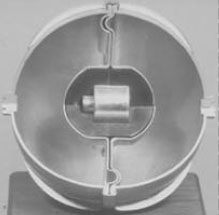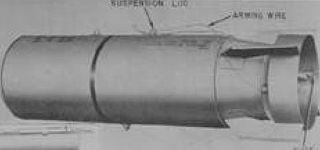
The M114 bomb was a four-pound U.S. anti-personnel bomb and biological cluster bomb sub-munition. The M114 was used in the M33 cluster bomb.

The M114 bomb was a four-pound U.S. anti-personnel bomb and biological cluster bomb sub-munition. The M114 was used in the M33 cluster bomb.
The M114 was a sub-munition for the M33 cluster bomb, as such, it was the first standardized U.S. biological weapon in 1952. [1] [2] The M114 was an improved version of a British World War II-era bomblet that was designed to disperse anthrax. [3]
The M114 was similar to a pipe bomb: it had a 530-millimetre (21 in) tube with a diameter of 41 mm (1+5⁄8 in). [1] 108 M114s were clustered into the M33 cluster bomb; [1] each had its own detonator and was ejected from the M33 while the bomb was still aloft. [4] Each M114 held 320 milliliters of Brucella suis . [1]
The United States biological weapons program officially began in spring 1943 on orders from U.S. President Franklin D. Roosevelt. Research continued following World War II as the U.S. built up a large stockpile of biological agents and weapons. Over the course of its 27-year history, the program weaponized and stockpiled seven bio-agents — Bacillus anthracis (anthrax), Francisella tularensis (tularemia), Brucella spp (brucellosis), Coxiella burnetii (Q-fever), Venezuelan equine encephalitis virus, Botulinum toxin (botulism), and Staphylococcal enterotoxin B. The US also pursued basic research on many more bio-agents. Throughout its history, the U.S. bioweapons program was secret. It was later revealed that laboratory and field testing had been common. The official policy of the United States was first to deter the use of bio-weapons against U.S. forces and secondarily to retaliate if deterrence failed.

The M139 bomblet was an American sub-munition designed for use in warheads as a chemical cluster munition. Each spherical bomblet held 1.3 pounds (590 g) of sarin nerve agent.

The E120 bomblet was a biological cluster bomb sub-munition developed to disseminate a liquid biological agent. The E120 was developed by the United States in the early 1960s.

The M33 cluster bomb, also known as the (M33) Brucella cluster bomb, was a U.S. biological cluster bomb developed in the early 1950s and deployed in 1952. It was the first standardized biological weapon in the U.S. arsenal.
The M115 anti-crop bomb, also known as the feather bomb or the E73 bomb, was a U.S. biological cluster bomb designed to deliver wheat stem rust.

The Flettner rotor bomblet was a U.S. biological sub-munition that was never mass-produced. Based on the vertical Flettner rotor which takes advantage of the Magnus effect, a force acting on a spinning body in a moving airstream, it was developed toward the end of the U.S. biological weapons program in the 1960s.
The E77 balloon bomb was a U.S. anti-crop biological munition based on the design of Japanese Fu-Go balloon bomb. The E77 used feathers as a vector to disseminate anti-crop agents from a hydrogen-filled balloon and was first developed in 1950.

The M34 cluster bomb was the first mass-produced United States Army weapon meant to deliver the chemical agent sarin (GB). A large stockpile of M34s was destroyed between 1973 and 1976.

The M43 BZ cluster bomb, or simply M43 cluster bomb, was a U.S. chemical cluster bomb intended to deliver the incapacitating agent known as BZ. The weapon was produced in the early 1960s and all stocks of U.S. BZ were destroyed by 1989.
The M138 bomblet was a sub-munition of the U.S. chemical weapon, the M43 BZ cluster bomb. The bomblet contained BZ, an incapacitating agent and was developed with the M43 in 1962. The M138s, along with all other U.S. BZ weapons were destroyed during the 1980s.

The M44 generator cluster was an American chemical cluster bomb designed to deliver the incapacitating agent BZ. It was first mass-produced in 1962 and all stocks of the weapons were destroyed by 1989.
The E14 munition was a cardboard sub-munition developed by the United States biological weapons program as an anti-crop weapon. In a series of field tests in 1955, the E14 was loaded with fleas and air-dropped.
The E86 cluster bomb was an American biological cluster bomb first developed in 1951. Though the U.S. military intended to procure 6,000 E86s, the program was halted in the first half of the 1950s.
The E61 anthrax bomblet was an American biological sub-munition for the E133 cluster bomb. This anti-personnel weapon was developed in the early 1950s and carried 35 milliliters of anthrax spores or another pathogen.
The E23 munition was a cardboard sub-munition developed by the United States biological weapons program for use as an anti-crop weapon. The E23 underwent a conversion for use as a vector weapon and was briefly used in large-scale entomological warfare trial but technical issues forced it from the tests.
The M125 bomblet was a U.S. chemical sub-munition designed to deliver the nerve agent sarin. It was brought into service in 1954 with the M34 cluster bomb as part of the first U.S. air-delivered nerve agent weapon.

The MC-1 bomb was the first U.S. non-clustered air-dropped chemical munition. The 750-pound (340 kg) MC-1 was first produced in 1959 and carried the nerve agent sarin.
The Vigo Ordnance Plant, also known as the Vigo Chemical Plant or simply Vigo Plant, was a United States Army facility built in 1942 to produce conventional weapons. In 1944 it was converted to produce biological agents for the U.S. bio-weapons program. Although the plant never actually produced bio-weapons before the end of World War II, it did produce 8000 pounds of an anthrax simulant. After the war, the plant was transferred to Pfizer, who operated it until the plants closure in 2008.
The Granite Peak Installation (GPI) — also known as Granite Peak Range — was a U.S. biological weapons testing facility located on 250 square miles (650 km2) of Dugway Proving Ground in Utah. The GPI was a sub-installation of Dugway but had its own facilities, including utilities. Established in 1943, GPI was deactivated with the end of World War II.